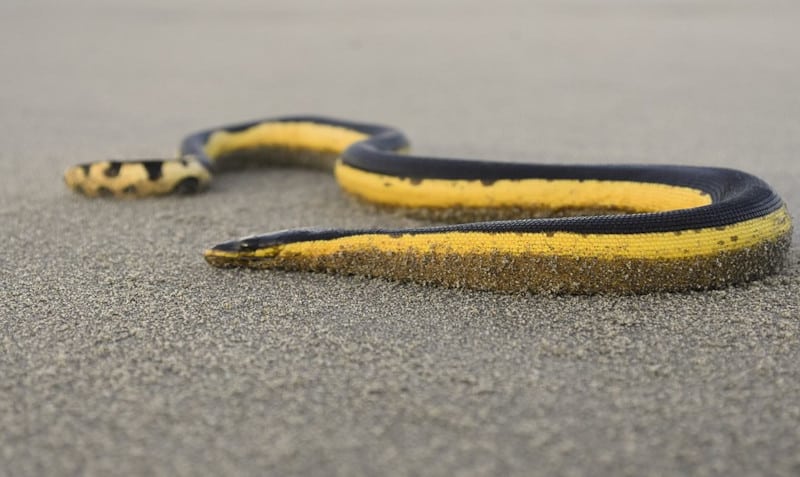Yellow-Bellied Sea Snake Facts
- The unusual, but descriptive, term of the Yellow-Bellied Sea Snake serves as the most often used common name for this remarkable species of marine reptile. It also goes by another name, though. That’s the equally informative name of Pelagic Sea Snake.
- Scientific professionals, however, such as researchers, typically use its official scientific name to refer to it. That’s actually a relatively simple name, though, at least compared to many others. That’s because it bears the formal name of the Hydrophis platurus.
- It also holds a notable distinction, which it shares with a multitude of other species. That’s due to the origin of that technical name. The eminent zoologist, Carl Linnaeus made the first formal acknowledgement of it as a separate and distinct species in 1776.
- For the moment, the fabulous marine reptile also holds yet another distinction. It represents one of the minority of species across the globe that appears to be holding its own in the face of the ecological upheavals the world’s now experiencing.
- As a result, its population numbers seem to be maintaining a level that’s both stable and sufficient. That further appears to hold true throughout the entirety of its natural range. The IUCN, therefore, presently lists it as Least Concern on its Red List.
- The amazing product of Nature and evolution nevertheless does face some potential threats to its existence. Commerical fishing practices pose a danger, in the form of accidental bycatch. Its greatest threat, though, likely consists of climate change.
Related Articles
Yellow-Bellied Sea Snake Physical Description
The stunning Yellow-Bellied Sea Snake manages to fully impress those who encounter it wholly regardless of sheer physical size. That’s because it actually ranks as smaller than average among its peers. Most related species, in fact, attain much larger sizes.
Nature, however, gives little regard to such things. The magnificent product of evolution also displays a moderate degree of the physiological characteristic of sexual dimorphism. In its specific case, though, this trait manifests itself in terms of simple length of body.
More precisely, males of the species grow to about 80% of the length of their female counterparts. Males of the animal reach an average body length of roughly 28 in (72 cm). The females, meanwhile, typically attain lengths averaging approximately 35 in (88 cm).
Otherwise, though, the two genders develop as virtually indistinguishable in appearance. The body of the reptile develops a compressed, tapered shape. This thins to less than half the diameter of the neck. The head, however, remains narrow, with an elongated snout.
Yet it’s the color scheme of the amazing Yellow-Bellied Sea Snake that generally catches the eye. That pattern of coloring also obviously serves as the source of the common name. The belly of the snake usually presents a bright yellow, though rarely brown appears.
Colors of the upper body vary significantly, however. Most frequently, though, this consists of varying shades of black or very dark brown. Infrequently, a series of small black dots appears on the lighter background. A set of black bars also makes the rare appearance.
- Kingdom: Animalia
- Phylum: Chordata
- Class: Reptilia
- Order: Squamata
- Family: Elapidae
- Genus: Hydrophis
- Species: H. platurus
Yellow-Bellied Sea Snake Distribution, Habitat, and Ecology
Luckily, both for the Yellow-Bellied Sea Snake itself, and for those who appreciate Nature, it holds one the widest ranges of distribution of any snake on earth. The only warm ocean in which the marine animal does not appear to live in natively is the Atlantic Ocean.
Even there, though, it’s occasionally seen, due to human activities carrying individuals outside the normal range. It principally natively inhabits the warmer oceans throughout the world, except the Atlantic. It’s also the only sea snake to reach the Hawaiian Islands.
The intrepid reptile greatly expands its territorial options due to its own nature. That’s because it evolved as an entirely pelagic creature. It therefore inhabits the vast open regions of the ocean, typically, though not exclusively, far from any shore in the area.
It further shows a marked preference for regions of free-floating kelp. It’s perhaps most frequently seen off the coast of Australia. In all areas in which it appears, however, the wonder of the seas prefers the same type of environment in which to make its home.
The reason the Yellow-Bellied Sea Snake so often prefers to inhabit regions of kelp pertains to two facets of its biology. These regions serve it well for both hunting and reproduction. Many of its favorite prey frequent such regions, and it generally seeks its mate there.
As opposed to ancient beliefs, the animal does require fresh water for survival. Amazingly, however, it gathers most of this by drinking freshwater precipitation that gathers on the surface of the ocean. It also breeds in warm waters, bearing live young, usually in tidal pools.
Species Sharing Its Range
Check out our other articles on 7 North American Desert Dwellers, Wilson’s Bird-of-paradise, Frying Pan Lake, Hibiscus Harlequin Bug, Chinese Giant Salamander, Pom-pom Crab, Tiger Shark

